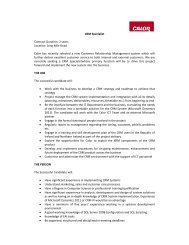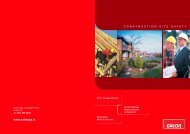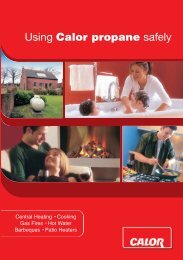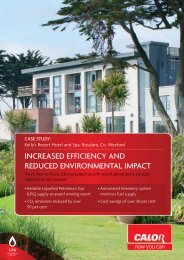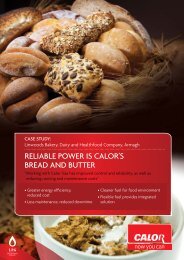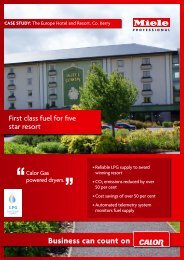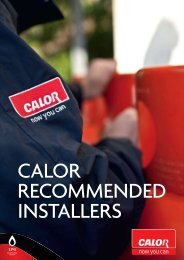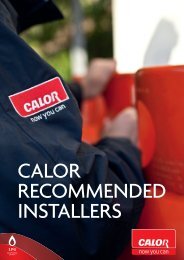CALOR LPG INSTALLATION mANuAL - Calor Gas
CALOR LPG INSTALLATION mANuAL - Calor Gas
CALOR LPG INSTALLATION mANuAL - Calor Gas
Create successful ePaper yourself
Turn your PDF publications into a flip-book with our unique Google optimized e-Paper software.
<strong>CALOR</strong> GAS<br />
gas Delivery –<br />
Access requirements<br />
OVERHEAD POWER CABLES<br />
Above ground tanks must not be sited directly beneath<br />
electrical power cables.<br />
• Where the voltage in the cables is less than 1kV, the tank(s)<br />
must be sited a minimum of 1.5m from an imaginary line<br />
drawn vertically downwards from the power cable<br />
• Where the voltage is 1kV and above, this distance must<br />
be increased to 10m.<br />
Where there is any doubt as to the cable voltage, guidance<br />
should be obtained from the local power supply company.<br />
SCREENING<br />
Screening an above ground tank is permitted providing that<br />
the screen:<br />
• is located on one side of the tank only<br />
• does not impede natural ventilation around the tank(s)<br />
• is either evergreen shrubs or non-flammable ranch<br />
type fencing<br />
Voltage 1kV and above<br />
10m 10m 1.5m 1.5m<br />
Fig. 5. Separation distances from overhead power cables.<br />
1m<br />
Non-flammable<br />
ranch type fence<br />
Voltage below 1kV<br />
1m<br />
TANKER DETAILS<br />
• Minimum width of entrance 4m<br />
• Minimum height clearance of entrance 4m<br />
• Working clearance around tanker during<br />
delivery is 3m<br />
SAFETY REQUIREMENTS<br />
• Normally, gas deliveries to domestic and small<br />
commercial customers are made with eight (8)<br />
tonne capacity tankers and to larger commercial,<br />
industrial and metered supplied sites with twelve<br />
(12) tonne capacity tankers.<br />
• It is very important that when deciding on the<br />
tank site location that there is safe and ongoing<br />
unrestricted access to deliver the tank, to carry out<br />
maintenance and for the gas delivery tanker to fill<br />
the tank safely.<br />
Tanker access requirements<br />
Customer Site<br />
Entrance<br />
4 Metres<br />
Gateway<br />
• Minimum turning circle 19.5m<br />
• 8 tonne tanker gross weight 18 tonnes<br />
• 12 tonne tanker gross weight 26 tonnes<br />
• Maximum hose length 27m<br />
• When making a delivery it is important that the<br />
tanker can be parked in a safe area, on a reasonably<br />
level hard standing, away from ignition sources and<br />
does not cause unnecessary obstruction to traffic.<br />
• It is an important safety requirement that during<br />
the filling operation the tanker driver has a clear<br />
view of the tanker and the tank that is being filled,<br />
and that there is an unrestricted access route<br />
available to traverse between the tanker and<br />
the tank.<br />
• does not obstruct the delivery driver’s line of vision when<br />
filling the tank<br />
• is located at least 1m away from tanks of less than 1000kg<br />
capacity (for NI this is less than 2.2 tonne <strong>LPG</strong> capacity).<br />
For larger tanks seek advice from <strong>Calor</strong> Customer<br />
Engineering Department.<br />
1m<br />
Evergreen Shrubs<br />
1m<br />
7.5<br />
Metres<br />
Public Road<br />
4 Metres<br />
8 Tonnes 8.4 Metres<br />
12 Tonnes 9.5 Metres<br />
Note: Chemical weed killers (such as Sodium Chlorate) or<br />
any other weed killing method which is a potential source<br />
of ignition should not be used in the separation areas.<br />
Fig. 6. Screening distances.<br />
2.5 Metres<br />
Fig. 7. NTS<br />
13 14



